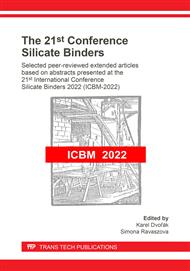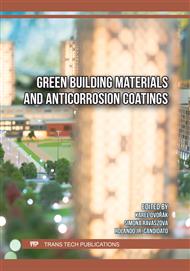[1]
P. Exnar, Metoda sol-gel, Technická univerzita v Liberci, Liberec, 2006.
Google Scholar
[2]
J. Pešek, J. Fiala, L. Rybák, B. Korsa, P. Fajfr, J. Hamáček, Žárobetony na bázi SiC s vazbou sol - gel, jejich odolnost vůči korozi struskou z komunálního odpadu.
Google Scholar
[3]
J. Pešek, J. Fiala, L. Rybák, B. Korsa, P. Fajfr, J. Hamáček, Bezcementové žárobetony s vazbou sol-gel, jejich výhody a nevýhody.
Google Scholar
[4]
S. Ghosh,R. Majumdar, B.K. Sinhamahapatra, R.N. Nandy, M. Mukherjee, S. Mukhopadhyay, Microstructures of refractory castables prepared with sol–gel additives, in: Ceramics International, pp.671-677,2003.
DOI: 10.1016/s0272-8842(02)00216-x
Google Scholar
[5]
D.A. Rani, F.D Gnanam, Sol–gel mullite as the self-bonding material for refractory applications, in: Ceramics International, pp.347-350, 2000.
DOI: 10.1016/s0272-8842(99)00062-0
Google Scholar
[6]
SK. S. Hossain, P.K. Roy, Waste rice husk ash derived sol: A potential binder in high alumina refractory castables as a replacement of hydraulic binder, in: Journal of Alloys and Compounds, 2020.
DOI: 10.1016/j.jallcom.2019.152806
Google Scholar
[7]
A.Kr. Singh, Study on the effect of different sols on high alumina castable refractory, 2017.
Google Scholar
[8]
S. Mukhopadhyay, S. Mahapatra, P. Mukherjee, T. Dasgupta, S. K. Das, Effect of Alumina Sol in No-Cement Refractory Castables, in: Transactions of the Indian Ceramic Society, pp.63-67, 2001.
DOI: 10.1080/0371750x.2001.10799968
Google Scholar
[9]
M. Nouri-Khezrabad, M.A.L. Braulio, V.C. Pandolfelli, F. Golestani-Fard, H.R. Rezaie, Nano-bonded refractory castables, in: Ceramics International, pp.3479-3497, 2013.
DOI: 10.1016/j.ceramint.2012.11.028
Google Scholar
[10]
R. Sarkar, Binders for Refractory Castables: An Overview, in: Interceram - International Ceramic Review, pp.44-53, 2020.
DOI: 10.1007/s42411-020-0112-x
Google Scholar
[11]
Y. Pivinskii, Cement-Free Refractory Concretes, Part 4: Refractory Concretes based on Silica Sol Binders, in: Refractories and Industrial Ceramics, pp.150-158, 2020.
DOI: 10.1007/s11148-020-00447-7
Google Scholar
[12]
S.H. Badiee, S. Otroj, Non-cement refractory castables containing nano-silica: Performance, microstructure, properties, in Ceramics, pp.297-302, 2009.
Google Scholar
[13]
Ibrahim M.I. Bayoumi, Emad M.M. Ewais, Ahmed A.M. El-Amir, Rheology of refractory concrete: An article review, in: Boletín de la Sociedad Española de Cerámica y Vidrio, 2021.
DOI: 10.1016/j.bsecv.2021.03.003
Google Scholar
[14]
S. Mukhopadhyay, S. Ghosh, M.K. Mahapatra, R. Mazumder, P. Barick, S. Gupta, S. Chakraborty, Easy-to-use mullite and spinel sols as bonding agents in a high-alumina based ultra low cement castable, in. Ceramics International, pp.719-729, 2002.
DOI: 10.1016/s0272-8842(02)00034-2
Google Scholar



